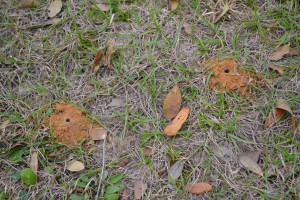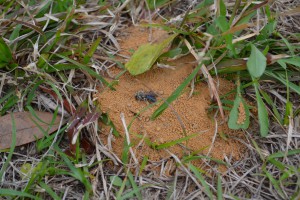The mining bees or adrenids are often seen in areas of landscapes that have little ground vegetation and loose soil. After mating, the female bee will excavate a very small tunnel in the ground that has several small cells attached to it.
The bee collects pollen and nectar to add to the cell and then lays a single egg in each cell. The emerging larvae feed on the nectar and pollen until it changes to an adult bee in the fall. There is only one generation a year. Although these solitary bees individually produce small nests, sometimes many will nest in close proximity to each other.
Solitary bees are not aggressive and stings are quite mild. Most solitary bees can be closely observed and will elicit no defensive behaviors. Perhaps the most common stings that occur are when the sweat bee, which is attracted to moisture, stings when swatted. Males of some solitary bees, which can not sting, will sometimes make aggressive-looking bluffing flights when defending a territory.
Like the most famous honey bee, solitary bees play a beneficial role in the pollination of plants. Their activity in the spring is short-lived and no management is necessary.
- Garden Spider Egg Sacs - October 23, 2025
- Saving Malabar Spinach Seeds - October 17, 2025
- Improve Butterfly Habitat with Trees - September 18, 2025


